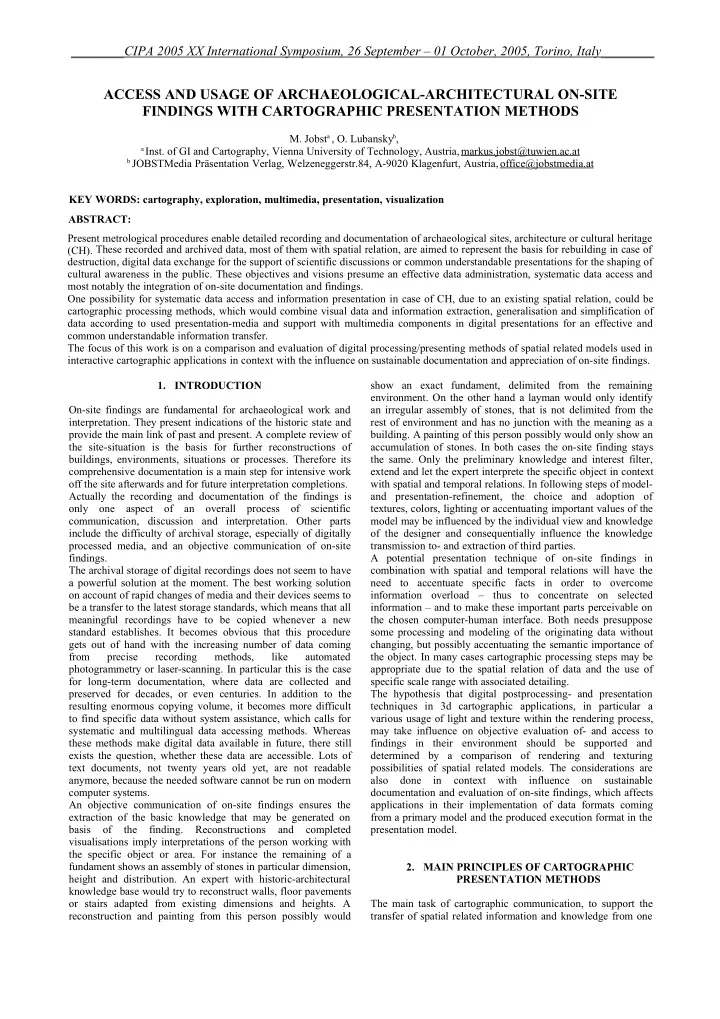

________CIPA 2005 XX International Symposium, 26 September – 01 October, 2005, Torino, Italy________ ACCESS AND USAGE OF ARCHAEOLOGICAL-ARCHITECTURAL ON-SITE FINDINGS WITH CARTOGRAPHIC PRESENTATION METHODS M . Jobst a , O . Lubansky b , a Inst. of GI and Cartography, Vienna University of Technology, Austria, markus.jobst@tuwien.ac.at b JOBSTMedia Präsentation Verlag, Welzeneggerstr.84, A-9020 Klagenfurt, Austria, office@jobstmedia.at KEY WORDS: cartography, exploration, multimedia, presentation, visualization ABSTRACT: Present metrological procedures enable detailed recording and documentation of archaeological sites, architecture or cultural heritage (CH). These recorded and archived data, most of them with spatial relation, are aimed to represent the basis for rebuilding in case of destruction, digital data exchange for the support of scientific discussions or common understandable presentations for the shaping of cultural awareness in the public. These objectives and visions presume an effective data administration, systematic data access and most notably the integration of on-site documentation and findings. One possibility for systematic data access and information presentation in case of CH, due to an existing spatial relation, could be cartographic processing methods, which would combine visual data and information extraction, generalisation and simplification of data according to used presentation-media and support with multimedia components in digital presentations for an effective and common understandable information transfer. The focus of this work is on a comparison and evaluation of digital processing/presenting methods of spatial related models used in interactive cartographic applications in context with the influence on sustainable documentation and appreciation of on-site findings. 1. INTRODUCTION show an exact fundament, delimited from the remaining environment. On the other hand a layman would only identify On-site findings are fundamental for archaeological work and an irregular assembly of stones, that is not delimited from the interpretation. They present indications of the historic state and rest of environment and has no junction with the meaning as a provide the main link of past and present. A complete review of building. A painting of this person possibly would only show an the site-situation is the basis for further reconstructions of accumulation of stones. In both cases the on-site finding stays buildings, environments, situations or processes. Therefore its the same. Only the preliminary knowledge and interest filter, comprehensive documentation is a main step for intensive work extend and let the expert interprete the specific object in context off the site afterwards and for future interpretation completions. with spatial and temporal relations. In following steps of model- Actually the recording and documentation of the findings is and presentation-refinement, the choice and adoption of only one aspect of an overall process of scientific textures, colors, lighting or accentuating important values of the communication, discussion and interpretation. Other parts model may be influenced by the individual view and knowledge include the difficulty of archival storage, especially of digitally of the designer and consequentially influence the knowledge processed media, and an objective communication of on-site transmission to- and extraction of third parties. findings. A potential presentation technique of on-site findings in The archival storage of digital recordings does not seem to have combination with spatial and temporal relations will have the a powerful solution at the moment. The best working solution need to accentuate specific facts in order to overcome on account of rapid changes of media and their devices seems to information overload – thus to concentrate on selected be a transfer to the latest storage standards, which means that all information – and to make these important parts perceivable on meaningful recordings have to be copied whenever a new the chosen computer-human interface. Both needs presuppose standard establishes. It becomes obvious that this procedure some processing and modeling of the originating data without gets out of hand with the increasing number of data coming changing, but possibly accentuating the semantic importance of from precise recording methods, like automated the object. In many cases cartographic processing steps may be photogrammetry or laser-scanning. In particular this is the case appropriate due to the spatial relation of data and the use of for long-term documentation, where data are collected and specific scale range with associated detailing. preserved for decades, or even centuries. In addition to the The hypothesis that digital postprocessing- and presentation resulting enormous copying volume, it becomes more difficult techniques in 3d cartographic applications, in particular a to find specific data without system assistance, which calls for various usage of light and texture within the rendering process, systematic and multilingual data accessing methods. Whereas may take influence on objective evaluation of- and access to these methods make digital data available in future, there still findings in their environment should be supported and exists the question, whether these data are accessible. Lots of determined by a comparison of rendering and texturing text documents, not twenty years old yet, are not readable possibilities of spatial related models. The considerations are anymore, because the needed software cannot be run on modern also done in context with influence on sustainable computer systems. documentation and evaluation of on-site findings, which affects An objective communication of on-site findings ensures the applications in their implementation of data formats coming extraction of the basic knowledge that may be generated on from a primary model and the produced execution format in the basis of the finding. Reconstructions and completed presentation model. visualisations imply interpretations of the person working with the specific object or area. For instance the remaining of a fundament shows an assembly of stones in particular dimension, 2. MAIN PRINCIPLES OF CARTOGRAPHIC height and distribution. An expert with historic-architectural PRESENTATION METHODS knowledge base would try to reconstruct walls, floor pavements or stairs adapted from existing dimensions and heights. A The main task of cartographic communication, to support the reconstruction and painting from this person possibly would transfer of spatial related information and knowledge from one
Recommend
More recommend